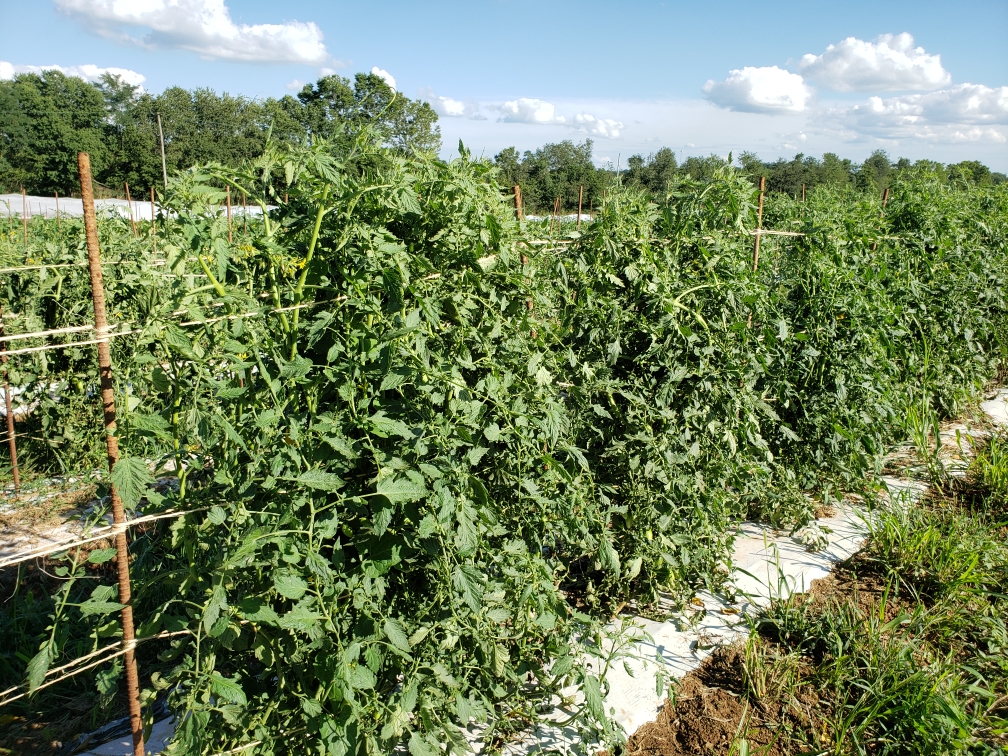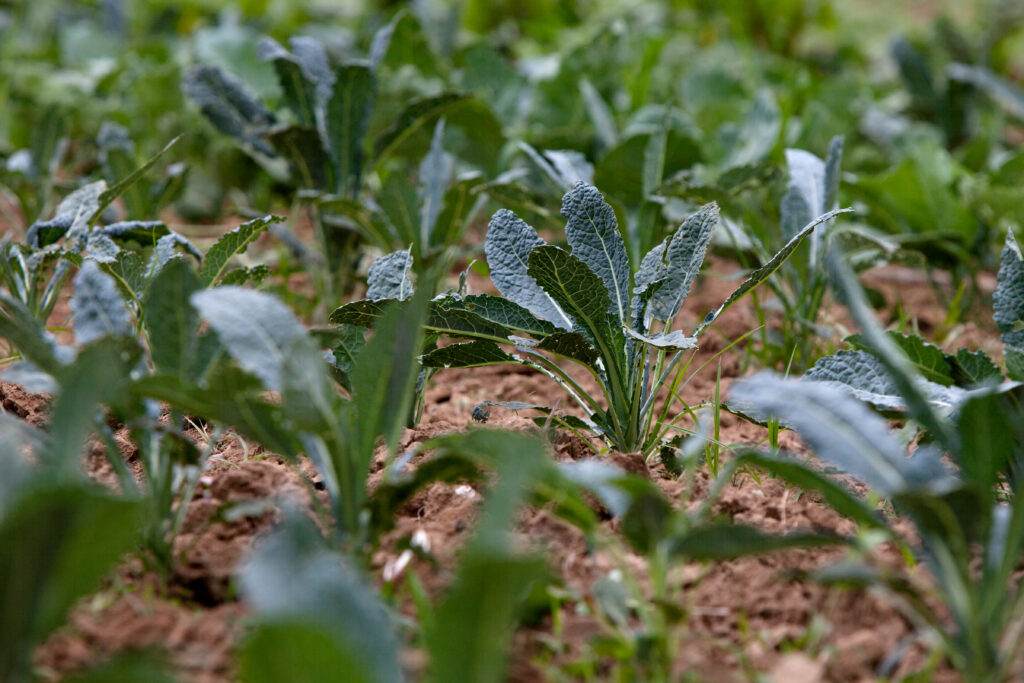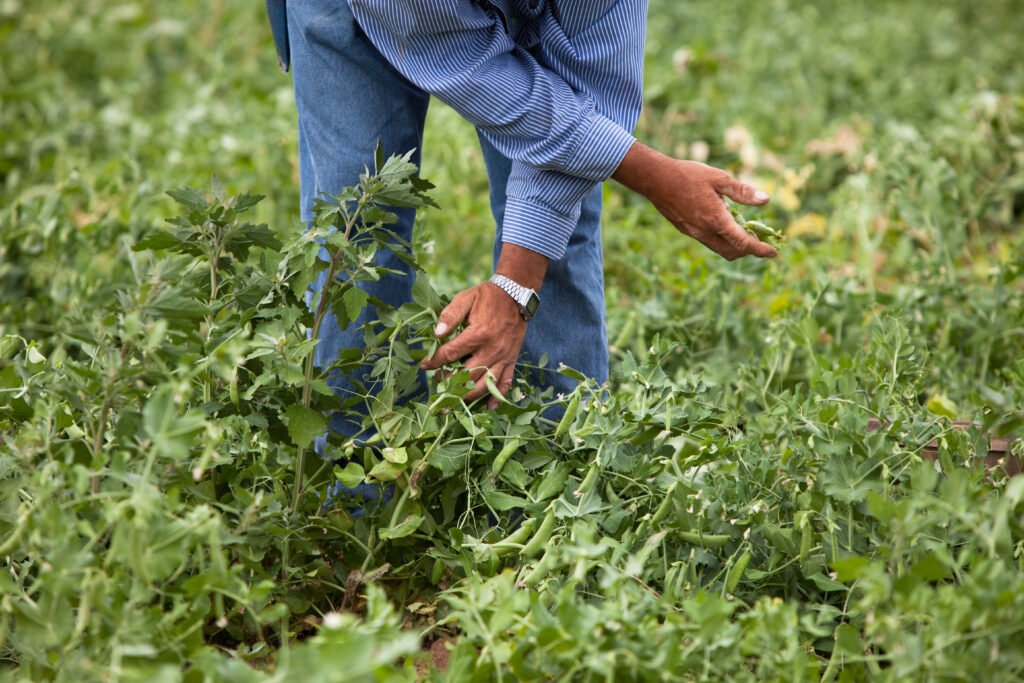Stepping away from the greenhouses, high tunnels and intensive-greens beds that we looked at in last week’s farm tour, we will look south and west to the produce production fields. Some years, we would have to hike north and east to see the same vegetables. Their placement depends on our eight-year crop-rotation plan. Remembering back to the soil building and beef cattle talk in the second farm tour, here is where we convert all of the energy (carbon) stored in the soil into human energy.
After five years of serving as livestock pasture, it’s time for us to grow vegetables in this field for three. There is a basic script of what plants go in which field and when, with a lot of inherent flexibility and a few hard-and-fast laws of nature that guide our decision making.

Across the sloping field, we see rows of dark-green plants, each with its own texture. The staked tomatoes stand tall and proud, shades of red peeking about halfway up the head-high plants. The cucumbers and zucchini arc their way along the ridge, their hand-sized male and female flowers open and welcoming Doug’s bees, necessary for pollination and, therefore, your food. We see rainbow chard about knee high and blue-hued Brussels sprouts and kale, as well.
These long-season, heavy-feeding crops are grown first after the cattle has nurtured the land. Not only was this field in livestock pasture for five years, last winter we unrolled the cow’s hay here. Each day, the big round bales are unrolled in a strip so the cattle can mimic their grazing behavior, as if they’re roaming a pasture full of fresh grass (in the dead of winter). In February, you can see the stripes from each day’s rations. By the end of winter, we’ve effectively evenly covered the entire field with feeding areas. This transports nutrients from the hay field into this one, plus the cattle waste is readily digestible food for the tens of thousands of species of microbes that, in turn, will feed your food crops.
No off-farm fertilizers are used on/in our vegetables. It’s been that way for at least 20 years. UK researchers have documented that this long-term crop-and-livestock approach to plant production is sustainable. The next generation will have it better than we did.

Trellising Tomatoes
As we walk the rows of tomatoes, a few bugs flying around, birds all about, the trellising system usually catches people’s eye. We efficiently stake thousands of tomato plants using the Florida weave. We drive 3/8-inch steel rebar every-other plant. We come back to walk up and down the rows with a backpack full of twine: Wrap the twine around the post twice, gather the foliage and stems from the following two tomato plants inside the twine, wrap the next post twice, and so on. At the end of the row, we come back the other way and gather the other side of the plant so the branches and fruits are supported. We do this every 6 or 8 inches up the stake as the plants grow. All this effort is not only to make the tomatoes easier to pick, but to keep them off the ground—fruit on the ground rots—and to promote good airflow as a primary plant-disease-control strategy.
Welcoming the Good Bugs
Looking more closely at individual plants, you see the leaves seem healthy, interspersed with clusters of ripening tomatoes, another cluster of green tomatoes a foot or so above them, and another clump of flowers above them. With the hot-dry weather this year, it looks like we will get four fruit sets. The soil microbes must be happy.
Flipping over a few leaves, we often find small insects, like aphids, hiding from the blaring sun. The size of cracked pepper, aphids can suck the life out of tomato plants if sufficient numbers of them overpopulate the field. This is where commercial growers would don their hazmat suit and respirator and spray a highly toxic synthetic chemical insecticide that kills aphids and the good bugs, too (and you, if you’re not careful). Here at Elmwood Stock Farm, you instead see evidence of beneficial-insect activity keeping the aphid population in check.
Having not released chemical insecticides on the farm in 20 years, the farm is now host to teeny, tiny, little braconid wasps, so small that the females deposit their eggs inside the aphid—not sure what that felt like to the aphid. In a few days, the egg hatches, eats the aphid’s insides, and burrows out, leaving a hard shell of a dead aphid, called a mummy.
Employing beneficial insects on the farm is simple but not easy. First, we need the right habitat and food source for these little wasps; then there has to be enough—but not too many—aphids around for them to lay their eggs. It works the same for the green lacewings, which you read about in the July 22 enewsletter, and the rest of the beneficials crew. It’s National Geographic right before your eyes.
Season to Season
At the end of this growing season, all the trellising and drip tape and row covers and row cover weights will be gathered up, the spent plants tilled under, and a small-grain cover crop sown—be it wheat, rye or barley that stays active and green all winter. The cover crop prevents erosion during harsh winters, for sure, and it also stimulates microbial activity that captures the carbon still available for growing crops. Next spring, with light tillage, we incorporate the cover crop into the soil—called green manure—feeding the microbes again. If the microbes aren’t happy, nobody’s happy.

Walking by—but not too closely by—the beehives, across the back driveway, you will see the second lineup of crops grown in the crop rotation. These are the crops that we’ll plant next year in the field we just looked at. Lettuces and leafy greens, carrots, beets—aka the spring garden. As these are shorter-season crops, we can actually get a spring crop and fall crop in this field. That’s how we grow 40 acres of vegetables on 30 acres of land.

In year three of the crop rotation, we plant legumes, peas and beans, since they have a symbiotic relationship with certain bacteria that capture nitrogen from the air and give it to the plant. We don’t have time to walk to those crops, as they are toward the back of the property, by John’s house, this year (and will be every eight years hereafter for the foreseeable future). This fall, that field will be planted to grass and clover to become pastures for beef production and carbon sequestration.
The lay of the land lends some fields to be more suitable for our crop-and-livestock rotation than others. There is a lot of work to make all this come together, but it is fueled by Mother Nature: solar energy, microbial activity and water. This is the type of farming John and Ann pictured when they came back to the farm after college.
Thanks for your support of our farming habits. The beneficial insects thank you, too. —Mac Stone



Made with 
